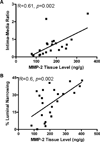The role of preexisting pathology in the development of neointimal hyperplasia in coronary artery bypass grafts
- PMID: 17631906
- PMCID: PMC4146434
- DOI: 10.1016/j.jss.2007.03.062
The role of preexisting pathology in the development of neointimal hyperplasia in coronary artery bypass grafts
Abstract
Objective: Saphenous vein grafts (SVG) used for coronary artery bypass surgery (CABG) often develop a gradual luminal narrowing over the first year due to neointimal hyperplasia (NH). Although the basic science of NH is well studied, our clinical understanding of this issue is limited. The purpose of this cohort study was to investigate clinical risk factors for NH by monitoring luminal narrowing within SVG using multichannel CT angiography (CTA).
Methods: Thirty patients underwent CABG involving SVG (N = 44) and arterial grafts (N = 36). Patient variables were recorded and the baseline quality of each conduit determined intraoperatively by analyzing surplus segments for intima-media thickness ratio (IMT) by histology and matrix metalloproteinase-2 by enzyme-linked immunosorbent assay. Percent luminal narrowing (%LN) was calculated for each patent graft by comparing the CTA appearance on day 5 to a repeat study at 1 y.
Results: Compared with arterial grafts, SVG showed significantly higher IMT at baseline (0.9 +/- 0.65 versus 0.22 +/- 0.17, P < 0.0001) and more %LN over the first year (6.9 +/- 7.5 versus 25.3 +/- 13.3% LN, P< 0.0001). Of all of the measured variables, the only significant predictors of %LN included baseline IMT (r = 0.58, P = 0.002) and matrix metalloproteinase-2 levels (r = 0.60, P = 0.002) in SVG.
Conclusions: The degree of NH at baseline, a phenomenon exclusive to SVG and not found in arterial grafts, was significantly related to the development of lumen loss in the conduit over the first year after CABG. The study of SVG using serial CTA may provide unique insights into the natural history of SVG remodeling and to identify factors that influence the long-term function of this conduit.
Figures




Similar articles
-
A Randomized Trial of External Stenting for Saphenous Vein Grafts in Coronary Artery Bypass Grafting.Ann Thorac Surg. 2015 Jun;99(6):2039-45. doi: 10.1016/j.athoracsur.2015.01.060. Epub 2015 Apr 15. Ann Thorac Surg. 2015. PMID: 25886810 Clinical Trial.
-
Correlates of saphenous vein graft hyperplasia and occlusion 1 year after coronary artery bypass grafting: analysis from the CASCADE randomized trial.Circulation. 2013 Sep 10;128(11 Suppl 1):S213-8. doi: 10.1161/CIRCULATIONAHA.112.000328. Circulation. 2013. PMID: 24030409 Clinical Trial.
-
Lumen loss in the first year in saphenous vein grafts is predominantly a result of negative remodeling of the whole vessel rather than a result of changes in wall thickness.Circulation. 2006 Jul 4;114(1 Suppl):I435-40. doi: 10.1161/CIRCULATIONAHA.105.001008. Circulation. 2006. PMID: 16820615
-
Repeat revascularization: Percutaneous coronary intervention after coronary artery bypass graft surgery.Cardiovasc Revasc Med. 2016 Jun;17(4):272-8. doi: 10.1016/j.carrev.2016.04.007. Epub 2016 Apr 28. Cardiovasc Revasc Med. 2016. PMID: 27215852 Review.
-
Saphenous vein graft disease: review of pathophysiology, prevention, and treatment.Cardiol Rev. 2013 Mar-Apr;21(2):101-9. doi: 10.1097/CRD.0b013e3182736190. Cardiol Rev. 2013. PMID: 22968180 Review.
Cited by
-
Vein graft failure: from pathophysiology to clinical outcomes.Nat Rev Cardiol. 2016 Aug;13(8):451-70. doi: 10.1038/nrcardio.2016.76. Epub 2016 May 19. Nat Rev Cardiol. 2016. PMID: 27194091 Review.
-
The Role of Immunomodulation in Vein Graft Remodeling and Failure.J Cardiovasc Transl Res. 2021 Feb;14(1):100-109. doi: 10.1007/s12265-020-10001-y. Epub 2020 Jun 16. J Cardiovasc Transl Res. 2021. PMID: 32542547 Free PMC article. Review.
-
Exploring the Potential of Saphenous Vein Grafts Ex Vivo: A Model for Intimal Hyperplasia and Re-Endothelialization.J Clin Med. 2024 Aug 14;13(16):4774. doi: 10.3390/jcm13164774. J Clin Med. 2024. PMID: 39200916 Free PMC article.
-
Vascular restenosis in coronary artery bypass grafting might be associated with VEGF-C/VEGFR-3 signaling pathway.Heart Vessels. 2018 Sep;33(9):1106-1120. doi: 10.1007/s00380-018-1158-9. Epub 2018 Mar 20. Heart Vessels. 2018. PMID: 29557990 Free PMC article.
References
-
- Fitzgibbon GM, Kafka HP, Leach AJ, et al. Coronary bypass graft fate and patient outcome: angiographic follow-up of 5065 grafts related to survival and reoperation in 1388 patients during 25 years. J Am Coll Cardiol. 1996;28:616. - PubMed
-
- Motwani JG, Topol EJ. Aortocoronary saphenous vein graft disease: Pathogenesis, predisposition, and prevention. Circulation. 1998;97:916. - PubMed
-
- Reardon MJ, Conklin LD, Reardon PR, et al. Coronary artery bypass conduits: Review of current status. J Cardiovasc Sur. 1997;97:916. - PubMed
-
- Zwolak RM, Adams MC, Clowes AW. Kinetics of vein graft hyperplasia: Association with tangential stress. J Vasc Surg. 1987;5:126. - PubMed
Publication types
MeSH terms
Grants and funding
LinkOut - more resources
Full Text Sources
Medical

